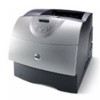Dell 5200n Mono Laser Printer Dell™ Workgroup Laser Printer M5200 Us - Page 119
Peer-to-peer, Network, Neighborhood, Install, Start, Settings, Printers, Properties, Server
 |
View all Dell 5200n Mono Laser Printer manuals
Add to My Manuals
Save this manual to your list of manuals |
Page 119 highlights
If you use the point and print method, a subset of driver information is copied from the server to the client computer. This is just enough information to send a print job to the printer. 1. On the Windows desktop of the client computer, double-click Network Neighborhood. 2. Locate the host name of the server computer, and then double-click the host name. 3. Right-click the shared printer name, and then click Install. Wait for the driver information to copy from the server computer to the client computer, and for a new printer object to be added to the Printers folder. The time this takes varies, based on network traffic and other factors. 4. Close Network Neighborhood. 5. Print a test page to verify print installation. 6. Click Start Settings Printers. 7. Select the printer you just created. 8. Click File Properties. 9. From the General tab, click Print Test Page. When a test page prints successfully, printer installation is complete. Peer-to-peer If you use the peer-to-peer method, the printer driver is fully installed on each client computer. Network clients retain control of driver modifications. The client computer handles the print job processing. 1. Click Start Settings Printers. 2. Click Add Printer to launch the Add Printer wizard. 3. Click Network Print Server. 4. Select the network printer from the Shared printers list. If the printer is not listed, type in the path of the printer in the text box. For example: \\\ The server host name is the name of the server computer that identifies it to the network. The shared printer name is the name assigned during the server installation process. 5. Click OK. If this is a new printer, you may be prompted to install a printer driver. If no system driver is available, then you will need to provide a path to available drivers. 6. 7.















